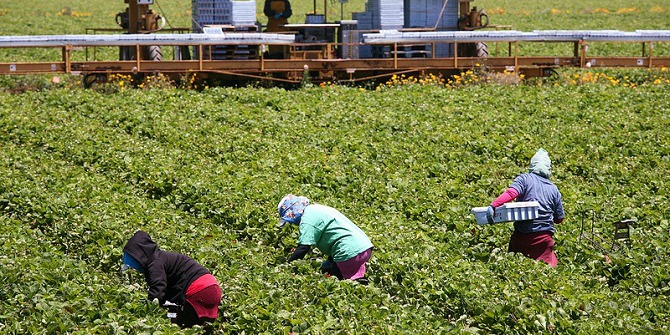 For those Mexicans that choose to do so, migration to the U.S. can be both incredibly costly and risky. But with annual wages less than a third the cost of migration, how are migrants able to afford to do so? Jeronimo Cortina looks at the role of Mexico’s Procampo agricultural assistance program, finding that its cash transfers are inadvertently encouraging many Mexicans to emigrate to the U.S. He argues that for the subsidy to achieve its purpose, then it must be conditional, or that instead, the Mexican government should create a regional structural fund aimed at rural counties in which migration is not yet prevalent to provide incentives to transform idle arable land into a productive investment, thus minimizing migratory pressures.
For those Mexicans that choose to do so, migration to the U.S. can be both incredibly costly and risky. But with annual wages less than a third the cost of migration, how are migrants able to afford to do so? Jeronimo Cortina looks at the role of Mexico’s Procampo agricultural assistance program, finding that its cash transfers are inadvertently encouraging many Mexicans to emigrate to the U.S. He argues that for the subsidy to achieve its purpose, then it must be conditional, or that instead, the Mexican government should create a regional structural fund aimed at rural counties in which migration is not yet prevalent to provide incentives to transform idle arable land into a productive investment, thus minimizing migratory pressures.
People migrate for many reasons. Most, do in search of greater opportunities, and the desire to help their families. Some are forced by necessity – profound economic deprivation, the intensifying effects of climate change, violence or even political unrest. Whatever may be the underlying reason, moving from one country to another is an expensive undertaking – even between close neighbors like the U.S. and Mexico.
There are countless expenses that a migrant has to pay in order especially if they are doing so outside national and international legal frameworks. However, among the most evident migration-related costs are those related to transportation and crossing the border. So how can people migrate given that most potential migrants do not necessarily have enough money to do so? In recent research, I look at this question by studying the impact of social assistance polices in the form of cash transfers on Mexican migration to the United States. Let’s look at some of these costs to illustrate a very interesting paradox.
On average, between 2000 and 2010, ground transportation from Southeast Mexico –one of the poorest regions of the country- to the U.S. border cost between US$ 60 and US$150, while the services of a smuggler ranged between US$1,500 and US$2,500, respectively (this does not take into account potential extortion). Now, at those times the average annual income per-person in Southeast Mexico was around US$890. So, how can a person migrate if it costs more than two-times what they can potentially make in a year?

The obvious answer to this question is that potential migrants can get money from loan-sharks, they could also sell property or assets or ask relatives already in the U.S. for help. The government via its public policies’ unintended consequences may provide another source of “financing”.
In my study I focus on how the Mexican government –inadvertently- may be contributing to the migration process by subsidizing some of the initial costs via its social assistance policies that grant small, direct and unconditionally monetary transfers. In particular, I study the effects of Procampo, a program from Mexico’s federal government designed to aid agricultural producers to compete in the global marketplace on migration. Using some advanced and not so advanced statistical modeling I show that Procampo is positively correlated with more county-level migration up to a certain threshold, while those that received the subsidy were more likely to migrate to the U.S. in comparison to those that did not receive the cash transfer. One interesting finding was that the effect was notably stronger among the poor than the wealthier simply because cash transfers increase household’s income and thereby relaxes budgetary constraints, allowing them to cover some of the initial costs associated with out-migration.
In an abstract way my findings suggest that public policies, to a greater or lesser degree frame the incentive structure faced by potential migrants in which they are confronted by the costs and benefits of various choices and their outcomes. What does this mean? Let’s look at some data: If producing on hectare of maize that yields around three tonnes costs around US$560 and the producer price per tonne around those years was around US$160, doing the math shows that this does not add up; the producer will be experiencing a loss even after getting the subsidy, which between 2000 and 2010 was around US$73 per hectare. So why invest time and money if the producer is not going to even cover his or her production costs? The producer would be better off if he or she could use the subsidy for other potentially more profitable purposes.
Using the subsidy for another purpose would not serve the interest of the state and potentially those of society in general so if the government wants cash-transfer’s recipients to comply with the purpose of the subsidy then they have to attach some rules. In the case of social assistance policies, the conditions attached to the subsidy matter. Social assistance policies with conditions (i.e., conditional subsidies) will make recipients pursue certain actions in order to receive the transfer; if there are no strings attached, people will seek to maximize their own utility than complying with the intended purpose of the subsidy. Now, when the subsidy is small and does not provide enough incentives for people to use it for its intended purpose due to market conditions, private information, etc. people may chose to use these monies for other purposes such as to cover some of the costs associated with migration.
Policy implications for the United States and Mexico – development not walls.
Any attempt at reforming the immigration system, either comprehensively or not, cannot ignore the regional nature of the issue. That is, migration cannot be “unilaterally” managed. Public policies have unintended consequences that affect countries on both sides of the border. What could be a win-win outcome for the U.S. and Mexico? For instance, the creation of a regional structural fund aimed at rural counties in Mexico in which migration is not yet a prevalent phenomenon could provide the necessary incentives to transform idle arable land into a productive investment, minimizing the migratory pressure that exists in those regions of the country opening the door to a system in which migration needs are matched.
Migration will not stop abruptly, Mexico and the United States need international migration: Mexico needs remittances and the United States needs labor. In order to arrive at a humane, beneficial and better-managed migration system in which the demand and supply of labor arrives at a potential equilibrium a co-development strategy between Mexico and the United States needs to be developed. This particular point has been absent from the discussion, omitting it or pretending that it does not exist is not going to change reality and the nature of the migratory phenomenon.
This article is based on ‘Subsidizing Migration? Mexican Agricultural Policies and Migration to the United States’ in the Policy Studies Journal.
Please read our comments policy before commenting.
Note: This article gives the views of the author, and not the position of USApp– American Politics and Policy, nor of the London School of Economics.
Shortened URL for this post: http://bit.ly/1l0Py61
_________________________________________
 Jeronimo Cortina – University of Houston
Jeronimo Cortina – University of Houston
Jeronimo Cortina is an Assistant Professor in the Department of Political Science and the Center for Mexican American Studies and a Research Associate at the Center for Public Policy at the University of Houston. Dr. Cortina specializes on survey research, immigration, and quantitative methods.






